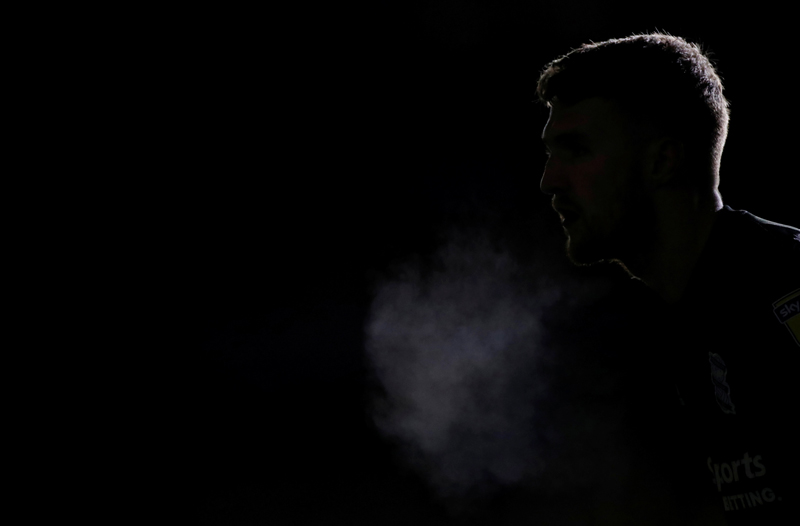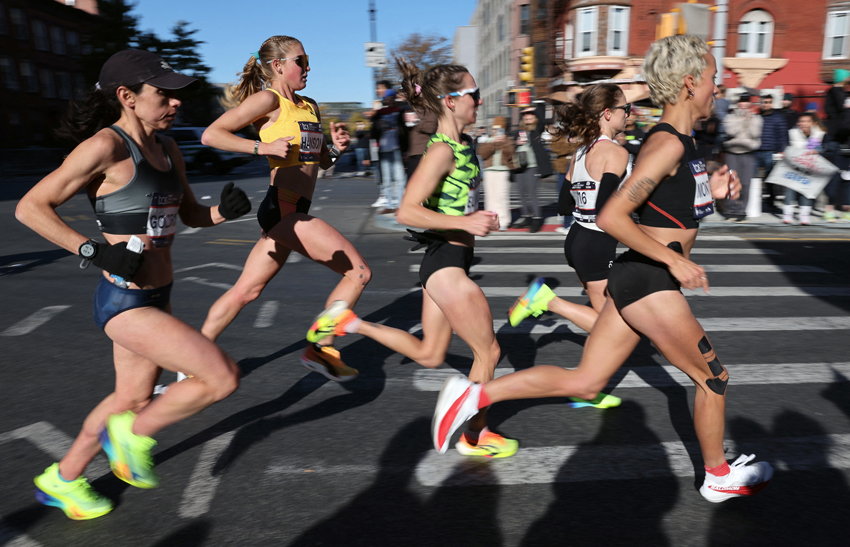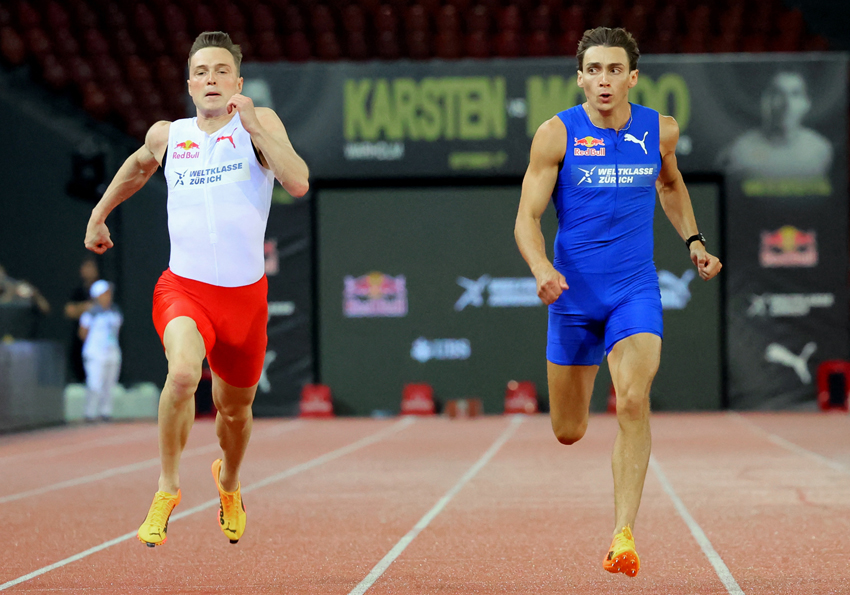EIB: cold comfort for athletes

Exercise-induced bronchoconstriction (EIB – where the bronchioles of the lungs become constricted during and after exercise) is a very common condition among sportsmen and women, regardless of age or athletic ability(1-3). The symptoms (see panel 1) typically begin shortly after exercise commences, and athletes also report occasional wheezing after the end of an exercise session. In all other respects however, the athlete feels well and has no other medical conditions.
Panel 1: Symptoms of EIB
Symptoms of EIB typically appear within a few minutes after exercising commences, lasting for around for 10 to 15 minutes after exercising has ceased. The most common symptoms of EIB include:
- Shortness of breath or wheezing
- Tightness in the chest
- Cough
- Sore throat
- Decreased endurance (because of the above)
The traditional thinking was that EIB is caused by a reaction to breathing cold air. However, subsequent research has suggested that it is the low humidity of the air, rather than its low temperature that is the trigger. It’s simply that cold air typically contains far less moisture than warm air, and quickly breathing dry air dehydrates the bronchial tubes, causing them to narrow and restrict airflow. In addition to dry/cold air, EIB can also be triggered by chemical irritants and pollutants – for example volatile chlorine compounds inhaled when swimming in a chlorinated pool and roadside pollution during heavy pollution episodes – eg summer smog. For most athletes however, it is the cold - and therefore dry – air that is responsible.
Is EIB the same as asthma?
Although EIB and exercise-induced asthma (EIA) are often regarded as one and the same thing, this is not strictly true. The term EIB is more accurate because while exercise triggers bronchoconstriction, it does not directly induce the clinical syndrome that defines asthma. Also, the condition of EIB can occur in sportsmen and women without the typical features of asthma. For these reasons, the term EIB is preferred and used here.
The precise physiological and biochemical mechanisms that are responsible for EIB are complex and poorly understood. However, what is fairly well agreed among scientists is that during exercise, the increased flow of air in the airways can act to ‘dry out’ the surface layer of cells in the airway tissues. This in turn can cause physiological changes in the cells below, which may cause them to shrink, stimulating the movement of ions and the release of cell signalling molecules, which ultimately lead to the contraction of the smooth muscle in the airways(4).
Symptomatic assessment of EIB
Although rare in healthy athletes, the presence of a cardiac problem can produce symptoms similar to EIB’ For this reason, coaches and sports clinicians should be aware of this possibility whenever they are faced with an athlete presenting with breathing difficulties and keep this in mind. Where any doubts or suspicions of cardiac involvement are present, cardiac screening should always be a priority – see this article. Athletes and coaches also need to be aware that self reporting of symptoms without follow-up testing is not a reliable method of diagnosing EIB. That said however, an initial assessment of the presence of EIB should evaluate the following:
- Does the athlete complain of shortness of breath, an increased breathing effort, chest tightness, wheeze and/or cough after exercise?
- Are these symptoms also accompanied by reduced performance or increased fatigue?
- Do the symptoms typically appear 5-10 minutes after the start of vigorous exercise (ie heart rate at or above 85% of maximum)?
- Do the symptoms usually subside within 30 minutes or so? If so, can the athlete perform a repeated bout of exercise shortly afterwards, with no repetition of the symptoms?
- Are the symptoms more common/more severe when the athlete swims in chlorinated pool water or exercises outdoors in cold conditions (the volatile chlorinated compounds released from pool water and the lower humidity levels that typify cold weather can both result in increased irritation to the airways(8,9))?
If the answer to all of these questions is ‘yes’ EIB can reasonably be suspected and a follow-up test can be performed (see later). If however the symptoms described above are more prominent during inspiration, are maximal at peak intensity and fade when exercise is stopped, this may indicate a transient upper airway obstruction, otherwise known as ‘exercise-induced laryngeal obstruction’. However, the only way to determine this for sure is to use direct visualisation of the upper airway during exercise using imaging techniques – something that can only be performed under medical supervision.
It’s also important to note that where the symptoms persist (see question 4) after 30 minutes, EIB can still be suspected since some symptoms associated with EIB (eg coughing) may actually arise from resulting stimulation of sensory nerves within the airway tree. Confusingly, for the same reason, the presence of coughing alone after exercise may also suggest that EIB is not present.
Clinical assessment of EIB
If an athlete or coach suspects he/she is suffering from EIB, a true diagnosis of the condition is required, which can only be made with the help of functional tests. Essentially, these will involve measurements of airflow using a ‘spirometry’ device (see panel 2). It’s important to point out that peak-flow measurements (sometimes used in fitness testing protocols) are of little use when it comes to evaluating the physiology of the airway in athletes and should not therefore be used. Also, while it might seem intuitive to challenge athletes with an exercise test and monitor responses, this approach is not recommended in the initial stages of investigation because not only are they difficult to perform reliably, their sensitivity for diagnosis is rather poor(10).
Panel 2: Spirometry devices
A spirometer is a device for measuring timed expired and inspired volumes of air, and hence indicates how quickly and effectively the lungs can be emptied and filled. Older readers with a background in physiology may remember the large volume-displacement devices with bellows or a water-sealed bell, which were standard issue in many physiology labs. These days however, most modern-day spirometers used in the clinical setting are electronic, flow-sensing devices. These include:
- Small, hand-held devices that provide digital readings - These are the cheapest options (typically costing around $500) and will fit into a medical bag. However, they do not provide a graphical display (spirogram) and therefore it may be difficult to judge when an expiration is complete. They also need to be used in combination with predicted charts and a calculator to interpret results.
- Portable meters with integrated printers - Typically more expensive than the devices above but will provide calculations, spirograms to monitor exhalations, and a printout including a flow volume loop.
- Systems designed to work with a computer - These will display a graph, make calculations of predicted values and reversibility and provide a printout for records. They also enable tests to be emailed for a second opinion and for electronic storage.
Whatever equipment is used, any device should be regularly calibrated, maintained, cleaned and disinfected according to the manufacturer’s instructions. Disposable ’one-way’ valved mouthpieces reduce the risk of cross infection (but prevent inspiratory flow-volume loops). If you are a coach with a number of athletes in your care, a good practice is to keep a calibration and maintenance log and list of athletes tested with the spirometer. This enables contact tracing if need be – for example, in case of unwitting testing of a tuberculosis patient.
Testing protocol
In the clinical setting, spirometry measurements while at rest are the norm, which of course is unlikely to be useful alone when trying to diagnose EIB in athletes. A bronchial provocation challenge is necessary therefore to establish evidence of variable airflow obstruction and demonstrate airway narrowing in response to a provocative substance – for example, a cold dry gas.
Typically, an athlete will perform two spirometry tests – one before and one after a bronchial challenge (designed to trigger EIB). A positive result is signified by a 10% or more fall in FEV1 in the second test compared to the first. [NB: FEV1 is defined as the maximum amount of air that the subject can forcibly expel during the first second following maximal inhalation]. If resting spirometry does demonstrate significant airflow obstruction, a bronchodilator challenge can be performed in order to look for evidence of reversibility of this obstruction. This is confirmed when the administration of a bronchodilator (a type of medication that makes breathing easier by relaxing the muscles in the lungs and widening the airways) produces an increase in FEV1 of more than 12% or 200mls of air expired(11,12). Figure 1 shows a step-by-step flow chart for the diagnosis of EIB.
Figure 1: Diagnostic algorithm for EIB
You need to be logged in to continue reading.
Please register for limited access or take a 30-day risk-free trial of Sports Performance Bulletin to experience the full benefits of a subscription. TAKE A RISK-FREE TRIAL
TAKE A RISK-FREE TRIAL
Newsletter Sign Up
Testimonials
Dr. Alexandra Fandetti-Robin, Back & Body Chiropractic
Elspeth Cowell MSCh DpodM SRCh HCPC reg
William Hunter, Nuffield Health
Newsletter Sign Up
Coaches Testimonials
Dr. Alexandra Fandetti-Robin, Back & Body Chiropractic
Elspeth Cowell MSCh DpodM SRCh HCPC reg
William Hunter, Nuffield Health
Keep up with latest sports science research and apply it to maximize performance
Today you have the chance to join a group of athletes, and sports coaches/trainers who all have something special in common...
They use the latest research to improve performance for themselves and their clients - both athletes and sports teams - with help from global specialists in the fields of sports science, sports medicine and sports psychology.
They do this by reading Sports Performance Bulletin, an easy-to-digest but serious-minded journal dedicated to high performance sports. SPB offers a wealth of information and insight into the latest research, in an easily-accessible and understood format, along with a wealth of practical recommendations.
*includes 3 coaching manuals
Get Inspired
All the latest techniques and approaches
Sports Performance Bulletin helps dedicated endurance athletes improve their performance. Sense-checking the latest sports science research, and sourcing evidence and case studies to support findings, Sports Performance Bulletin turns proven insights into easily digestible practical advice. Supporting athletes, coaches and professionals who wish to ensure their guidance and programmes are kept right up to date and based on credible science.









